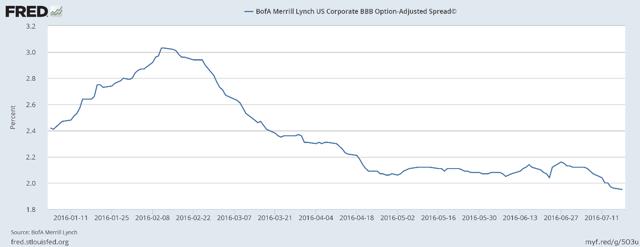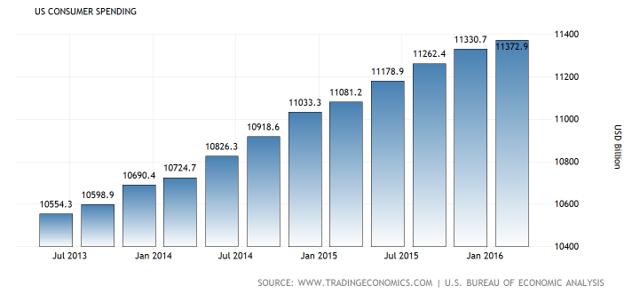I believe that the market is no longer fearful [and that] gold has had its moment. After a multi-year rout gold began to pick up pace in 2016 when uncertainty seemed to be omnipresent…[but] my view has stayed consistently positive as I have not identified any material weakness in the economy…[Let me explain why that is the case.]
rout gold began to pick up pace in 2016 when uncertainty seemed to be omnipresent…[but] my view has stayed consistently positive as I have not identified any material weakness in the economy…[Let me explain why that is the case.]
The comments above and below are excerpts from an article by The Traveling Investor which has been edited ([ ]) and abridged (…) to provide a faster and easier read.
Credit Spread
Credit spreads are affected by investor sentiment. In a risk-on environment, credit spreads shrink. The opposite happens when the market is fearful.
We reached the height of fear in early 2016, when credit spreads spiked to multi-year highs. Since then, credit spreads have shrunk dramatically. I believe that this is indicative of positive sentiment because there have been no shifts in major economic indicators such as job numbers and consumer spending. Credit spreads didn’t shrink because the economy was doing a lot better than before (the economy was never sinking in the first place), but they shrank because investors are no longer concerned about a theoretical doomsday scenario.
Consumer Spending
Consumer spending will tell us about the actual improvement in the economy.
In the chart above we can see that consumer spending has continued to climb quarter after quarter. I must admit that this is a lagging indicator, so it does not tell us what will happen in the future. However, this is one of the factors that contributes to the positive sentiment in the market.
Rate Hike
Finally, we have the impending rate hike. We all know how the Fed can be schizophrenic. It says it’s going to do one thing but then does something else. Usually the justifications aren’t good reasons, but are excuses that merely delay the inevitable. Brexit was a perfect example; I’m not sure how much time the FOMC has spent in studying its effects, but one word that often comes up is “uncertainty.” The Fed can’t be bothered to deal with uncertainty (what if it makes a bad move?), so it sticks with the status quo but excuses are running out. Positive economic data and the lack of more “uncertainties” are putting a rate hike back on the table. As interest rate increases, gold tends to fall as treasuries become more attractive (i.e. one can get more yield with treasuries vs. no yield with gold).
Conclusion
I believe that the market is no longer fearful.
- Credit spreads have shrunk dramatically even though economic data has been fairly consistent and
- consumer spending is telling investors that the economic engine is still working fine. This indicates that the market is no longer pessimistic.
- The Fed has also been somewhat “fearful” of the various uncertainties. However, the path is now clear for another rate hike.
While I do not know what crazy story could develop next week, given the current information, it is clear to me that fear has subsided. As such, gold is no longer attractive as an investment in fear. If you are interested to see how gold can be used strategically and tactically, read You Are Not Using Gold Correctly.
Disclosure: The above article has been edited ([ ]) and abridged (…) by the editorial team at  munKNEE.com (Your Key to Making Money!)
munKNEE.com (Your Key to Making Money!)  to provide a fast and easy read.
to provide a fast and easy read.
“Follow the munKNEE” on Facebook, on Twitter or via our FREE bi-weekly Market Intelligence Report newsletter (see sample here , sign up in top right hand corner)
Links to More Sites With Great Financial Commentary & Analyses:
ChartRamblings; WolfStreet; MishTalk; SgtReport; FinancialArticleSummariesToday; FollowTheMunKNEE; ZeroHedge; Alt-Market; BulletsBeansAndBullion; LawrieOnGold; PermaBearDoomster; ZenTrader; EconMatters; CreditWriteDowns;
 munKNEE.com Your Key to Making Money
munKNEE.com Your Key to Making Money


